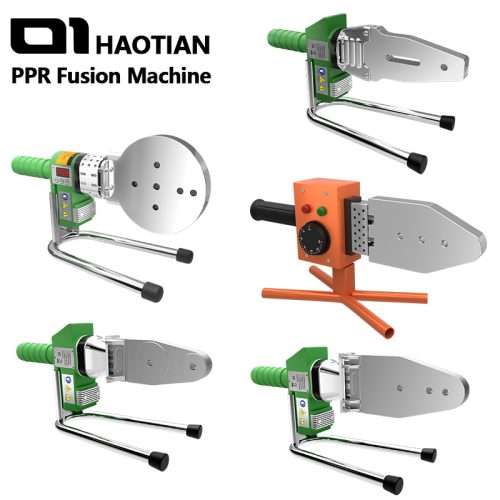PPR fusion welders are highly efficient and reliable tools used to connect PPR pipes and fittings. However, during actual use, many users may encounter issues that affect work efficiency or lead to poor connection quality. This article will delve into some of the most common problems with PPR fusion welders and provide effective solutions to help users avoid mistakes, ensuring the quality of pipe connections.
1. Incorrect Heating Temperature
Problem: If the heating temperature is too high or too low, it can result in poor connection quality, even damaging the pipes or fittings.
- Overheating: Excessive heat can cause the PPR pipe and fitting surfaces to over-melt, making the joint unstable and potentially causing deformation or burning.
- Underheating: Insufficient heat will fail to properly melt the connection area, leading to an insecure bond, which may result in leakage.
Solution:
- Ensure that the fusion welder’s temperature control system is accurate, typically between 250°C and 270°C.
- Regularly check the temperature gauge to ensure the device is operating at the correct temperature.
- If the welder lacks automatic temperature regulation, manually adjust and monitor the temperature during use.
2. Inaccurate Heating Time
Problem: Incorrect heating time can affect the fusion quality.
- Too long: If heating time is excessive, the pipe and fitting surfaces may become excessively melted, causing instability in the connection, potentially leading to cracks or leaks.
- Too short: Inadequate heating time will result in insufficient melting of the pipe and fitting surfaces, leading to a loose joint.
Solution:
- Follow the heating time guidelines specified in the product manual based on the size of the PPR pipe and fusion welder model.
- Control the time the pipe and fitting are in contact with the heating plate to ensure sufficient melting of the connection area.
3. Misalignment of Pipe and Fitting
Problem: After fusion, incorrect alignment of the pipe and fitting may cause the joint to loosen or leak.
- Incorrect alignment: If the pipe and fitting are not aligned properly during fusion, the melted connection area may become uneven, compromising the seal.
- Uneven pressure: Applying inconsistent pressure during the fusion process can cause an imperfect connection, affecting joint integrity.
Solution:
- Ensure that the pipe and fitting are properly aligned during the heating process, maintaining a perpendicular position to each other.
- Apply even pressure during fusion to ensure a uniform bond and proper alignment of the parts.
4. Contaminated Pipe or Fitting Surface
Problem: Any dirt, oil, or moisture on the pipe or fitting surfaces will negatively affect the fusion process and result in weak connections.
- Moisture: Moisture on the pipe and fitting surfaces will prevent them from properly melting, increasing the risk of fusion failure.
- Oil and dirt: Contaminants can impede the heating process, leading to an uneven fusion and poor connection.
Solution:
- Clean the pipe and fitting surfaces thoroughly before fusion to remove any contaminants such as dirt, oil, or moisture.
- Use a clean cloth or specialized cleaning agent to wipe down the surfaces, ensuring proper contact between the pipe and fitting.
5. Fusion Welder’s Temperature Control System Failure
Problem: A malfunctioning temperature control system can lead to unstable heating, affecting the connection quality.
- Symptoms: The temperature may fluctuate, displaying incorrect readings or failing to maintain a consistent heating temperature.
Solution:
- Regularly inspect the temperature control system of the fusion welder to ensure it is functioning properly.
- If the system malfunctions, contact a professional technician for repair.
6. Insufficient Cooling Time
Problem: After fusion, if the pipe and fitting are not allowed to cool for the recommended time, the connection may not set properly, causing leakage or instability.
- Cooling too fast: Rapid cooling can cause cracks or deformation in the fusion area.
- Cooling too slow: Excessive cooling time can delay the project, impacting efficiency.
Solution:
- Adjust the cooling time based on pipe size and ambient temperature conditions.
- Avoid applying external pressure on the connection area during cooling to ensure stability.
7. Mismatched Pipe and Fitting Sizes
Problem: Using pipes and fittings with mismatched sizes can cause improper fusion or installation difficulties.
- Mismatched specifications: If the pipe and fitting sizes do not align, the fusion process will be ineffective, resulting in weak connections or difficulty completing the installation.
Solution:
- Always ensure that the pipe and fitting sizes match before starting the fusion process.
- Consult professionals if you are unsure about the compatibility of the components.
Conclusion
PPR fusion welders play a crucial role in modern pipe installation for water, heating, and HVAC systems. By understanding and addressing common issues, users can enhance their efficiency, avoid mistakes, and ensure the long-term stability of pipe connections. Proper use of the PPR fusion welder and awareness of potential problems is essential for every plumber or installer looking to achieve high-quality, reliable pipe systems.
As a leading international supplier of PPR fusion welders, [Your Company Name] offers high-quality, reliable, and durable welding equipment for global markets. Our PPR fusion welders are perfect for residential, commercial, and industrial applications. With competitive pricing, fast worldwide shipping, and exceptional customer service, we are your trusted partner for all PPR welding needs. Contact us today to learn why we’re the go-to supplier for PPR fusion welding solutions!









